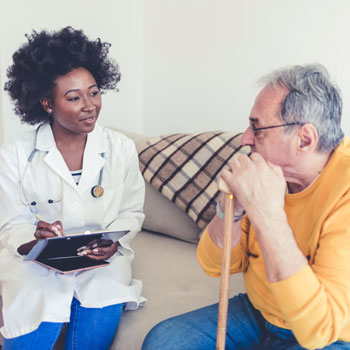Ask the right questions to diagnose dyspnea
An expert offers advice on diagnosing dyspnea, which can affect about one-third of ambulatory people older than age 65 years.
If you're sure you know what a patient with dyspnea looks like, you might be wrong, according to Matthew Griffith, MD, MPH.
The usual picture involves someone wearing oxygen, or someone who's visibly in distress and is unable to catch their breath, said Dr. Griffith, who is a pulmonary and critical care medicine physician at the University of Colorado Anschutz Medical Campus and Rocky Mountain Regional VA Medical Center in Aurora.

“We don't think necessarily of dyspnea as people who … are bedbound or have limited mobility, who may be very happily breathing sitting in their bed or in their recliner,” he said. “Essentially, they're not making demands of their body, and so they don't have a chronic perception of dyspnea. This is a classic challenge that we run into in this population of older adults.”
Dr. Griffith offered this and other advice on diagnosing dyspnea during the American Geriatrics Society's annual meeting, held in Chicago in May.
Daily dyspnea affects about one-third of ambulatory people older than age 65 years, Dr. Griffith said. He compared its physiology to a thermostat and a furnace.
“There are certain sensors which indicate it's time to kick in the furnace—it's time to start breathing more—and then the furnace sort of picks up its output and delivers more heat, let's say, to the system,” he said. “There are sensors in the body that sense a shortness of breath, and then there are actions that the body will take to alleviate this, and the imbalance of these sensors is part of the problem.”
Another key fact about dyspnea is that it is not defined by oxygen saturation, Dr. Griffith said. Rather, it's the sensation of difficulty breathing. “If a patient has a great oxygen saturation…that may not mean he's free of shortness of breath,” he said. “If somebody's oxygen level is reassuring, that doesn't rule out potential severe dyspnea.”
Hypoxia, hypercapnia, and irritants in the lung are all chemical stimuli that can contribute to dyspnea, while mechanical stimuli include air flow, air temperature, lung inflation, lung irritation, and chest wall limitation, Dr. Griffith said. In addition, once the brain has gotten the signal from the body that it needs more air, laryngeal patency, breath size, and respiratory rate can increase.
There's also a psychological component, as the sensation of dyspnea can be worse in patients with pre-existing anxiety. “We also know that the brain has the ability, by itself, to sort of decrease that sensation of dyspnea, even though we are receiving numerous negative signals,” Dr. Griffith said.
Dyspnea is in some ways a normal part of aging, Dr. Griffith explained, due to decreases in peak air flow, loss of alveolar surface area, and recoil respiratory muscle weakness. “That's something I want you to walk away with from here today. … Normal aging can cause the sensation of dyspnea, and that's important,” he said. He noted that such patients may not respond to medication because their dyspnea is not caused by a reversible pathologic process.
New recommendations for diagnosing chronic obstructive pulmonary disease (COPD) illustrate this evolving understanding, Dr. Griffith explained, as they use Z scores, or deviations from an age-adjusted norm, rather than a fixed cutoff for forced expiratory volume in one second. “Even our diagnoses of disease states are changing to acknowledge the fact that lung capacity drops with aging and is not necessarily an indication for throwing a bunch of inhalers at your patients,” he said.
How can clinicians tell the difference between pathology and the effects of aging? Dr. Griffith recommended asking about “the usual suspects” to identify true dyspnea, especially in low-mobility patients. Questions can include “When did it start? Is it an acute event versus a gradual chronic process? Was there a medical event or other life change that preceded the dyspnea? How often do you get it? Are there things you do that make it better or worse?”
Associated symptoms, such as orthopnea, cough, phlegm production, and chest tightness or wheezing, can also help distinguish between pulmonary and nonpulmonary causes, Dr. Griffith said. He added that chronic dyspnea can involve disrupted sleep, even if it's not associated with sleep-disordered breathing.
Regarding associated exposures, physicians are probably already asking about tobacco use, but airborne occupational exposures are a common cause, too. “Maybe as high as 15% to 20% of older adults with obstructive lung disease … [it's] the result of a chronic occupational exposure,” Dr. Griffith said. “It's not just your classic stone worker…Janitors, who are exposed to a lot of cleaning chemicals, over time they'll just develop a sort of occupational asthma that we look for … but can develop fixed airway obstruction.”
Also, the effects of aging are not reversible, so if symptoms vary seasonally, for example, they may be disease-related. Another clue is that exacerbations of dyspnea cannot be attributed to aging.
There are, of course, tools to assess pulmonary function, but they aren't always effective in older adults. “We lack a really defined geriatric system of assessment for this condition,” Dr. Griffith said. “If you look at the standard COPD assessment test or the way we characterize the severity of COPD symptoms, you can see that many of these are not really applicable to many of the patients we see in our clinics.” For example, asking about breathlessness after walking up a hill or one flight of stairs may not help pinpoint dyspnea in patients who don't often leave the home.
Dr. Griffith recommended that physicians who use these standard assessment tools include a couple of additional questions, such as asking patients about the most strenuous activity they do during the day and whether they've stopped doing any activities because of dyspnea.
“I would prompt people not to just think of the chores that they're not doing around the house anymore, but the socially isolating things, too,” he said. “You stop going out and meeting the Friday-morning donut group. You stop playing bingo with your friend. Are you changing your habits because of difficulty breathing?”
Testing can also help differentiate normal aging from pathology, Dr. Griffith explained. “Aging does not cause hypoxia,” he said. “We know that aging generally causes changes in pulmonary mechanics and physiology, but unless there's been severe destruction of the alveolar blood-air interface, they should not experience hypoxia.”
And don't forget about spirometry, Dr. Griffith noted. “There are a lot of spirometry devices that potentially could be integrated into your practice,” he said. “There's pretty good data that they're reliable, and we're going to be publishing some data showing that they're reliable even in older adults with cognitive dysfunction and severe functional limitation.”
He also recommended a good old-fashioned chest X-ray. “Spirometry and a chest X-ray,” he said. “You don't need CT scans, you don't need high-resolution CT scans—a simple chest X-ray can pick up a lot of important information.”
Getting an accurate diagnosis of the cause of dyspnea is vital for many reasons, including appropriate prescribing. Dr. Griffith was the first author on a March 2020 study in the Journal of General Internal Medicine finding that 14.3% of patients who had been misdiagnosed with COPD were unnecessarily taking inhaled corticosteroids.
Dr. Griffith encouraged his audience to refer patients with dyspnea to pulmonologists when necessary and said that smoking cessation counseling offers the chance of an easy win, since many of the initial concerns about the safety of drugs for this purpose, such as varenicline and bupropion, in older patients have been mitigated by newer data.
Finally, he stressed the importance of pulmonary rehab for patients with COPD. “When it's been studied in older adults, even if they just complete one pulmonary rehab session, they've reported subjective improvement in dyspnea,” he said. However, referral rates are low: A study published in the May 2024 Annals of the American Thoracic Society found that only 2.5% of Medicare beneficiaries with COPD completed one or more day of pulmonary rehab in 2013, with an increase to just 4.0% in 2019. It can also be hard to get patients to keep up with pulmonary rehab, he noted; the same study showed that 50% of patients attended four or fewer sessions.
New delivery methods may change those numbers going forward, though. “There's great data coming out now about telepulmonary rehab that can be done in the home and that shows equal efficacy and benefits,” Dr. Griffith said. “You'll see more of those trials coming up.”




